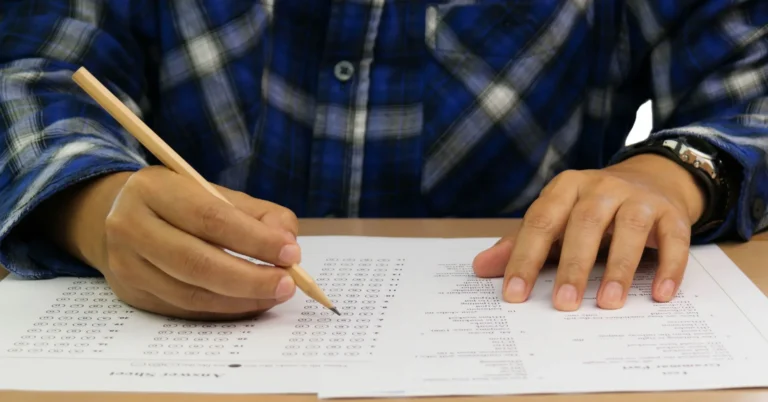How Do I Write an Anonymous Letter?
Approach an anonymous letter as if writing a normal letter. The only big difference is that you will not include your name or any other personal details. Otherwise, the basic layout and structure of the letter are the same as normal. This means that the content of your anonymous letter is dependent on what you want to write about, to whom and why.
The first tip for writing an anonymous letter is not to write it. This does not mean giving up on the whole venture, but it does mean typing it instead. It may seem paranoid to not hand-write the letter, but typing removes the possibility of your handwriting being spotted. Use a typewriter or a computer instead. If the letter is extremely sensitive in nature, regarding information you do not want traced back to you, then consider using generic paper and printers in a print shop rather than your home printer.
Include the address of your target in the letter, but exclude yours. Keep the top-right area of the letter blank. Instead, begin the letter with the date on the top-left and then your target’s address immediately below it. Address the letter as normal with “Dear sir/madam,” “To whom it may concern,” “Dear Title” or “Dear Joe Bogs.”
Think carefully about the content of the anonymous letter before you write it. What do you want to say and why? Hone in on the details and the arguments and do not let yourself get distracted. Remember to thoroughly edit your letter and fact check wherever possible. You do not want your arguments to be ignored because of basic errors.
There are many legitimate reasons for writing an anonymous letter. Basic examples include letters of complaint, such as to a restaurant for their bad service, or letters to a writer whose opinions you do not agree with. Many times, people who write to advice columns choose to write anonymously due to the potentially embarrassing nature of their question or problem.
Two important types of letters that are usually anonymous are the whistleblower and those reporting people for something. With these two examples, it is especially important to get all of your facts correct and in place. It can also be very important to not reveal your identity, as doing so often has consequences.
Once finished, sign the letter however you wish; this could be a simple “anonymous” or “a concerned employee” or something similar. Bear in mind that when mailing the letter, some recipients will do their best to work out who sent it. You may want to mail the letter from a different post code or while on a business or pleasure trip away from home or email the letter from a generic mail service with a new email address set up just for that one email.
How To Sign an Anonymous Letter
It might be best to not sign the letter at all. The most important aspect of an anonymous letter is to remain anonymous. Signing the letter with your name will absolutely defeat the purpose of what you are doing. Instead of signing with your name, you could just put “concerned citizen” or whatever might work with the context. Leaving no signature or by line ensures that no one can try and track you down through that information.
Signing with another person’s name is not a good idea because it could cause legality problems. Be sure to not use a phrase or spelling that could get linked back to you. Leaving a nickname could also link back to you if someone is familiar with your nickname. Don’t use usernames such as handles from video games or social media accounts because that could also link to you if someone did some data mining into the past.
How To Send an Anonymous Letter Without Getting Caught
How you send the letter will depend on how you want it to be delivered; physically or digitally. Whether you are printing out the letter and physically sending it, or you are submitting it by email, you’ll want to hide your footprints. Anonymous letters are sent all the time by good people for many different reasons. Anonymous letters shouldn’t be perceived as bad things or necessarily illegal.
Snail mail can be a good way to launder the paper trail, but you’ve got to be creative. If you send the letter from your mailbox, the post office will print onto the envelope which station(s) the letter passed through, thus revealing the local area of where the letter was sent from. Certainly, you’ll want to drop the letter off at a post office far away from your home, or first mail the letter to a remote location where it can be opened and re-mailed again.
If you are trying to send an email that should remain anonymous, there are some steps involved to ensure the secrecy of the sender. A good example of this is when Edward Snowden first sent evidence to media contacts. He later revealed to those contacts who he was, but he was first using an anonymous letter.
A good method of sending an anonymous email nowadays is to utilize both VPNs and the TOR network before assembling and transmitting the letter. Here are some general steps to follow:
Hiding Digital Sender Information
- Use VPN to change IP address to another country
- Connect to TOR
- Use a fully anonymous and encrypted email service such as Protonmail
- Create a brand new account on Protonmail or another messaging service without using any of your personal information
- Type the letter from scratch instead of opening a pre-typed file, or re-type from the file
- Send the email, and if necessary, leave an anonymous way to contact back such as a burner phone number or check replies to Protonmail or preferred messaging service
How To Find Out Who Wrote an Anonymous Letter
Physical Letters
If the letter is on paper, maybe the person wrote it by hand. If they did write it by hand, then in the end there could be a much higher chance of revealing the person who wrote it by matching the handwriting. A typed letter could also be simple to trace back to the origin, but only if the ink or the paper used can link back to a specific area. For example, if a typed letter has ink from an inkjet printer that is used only on certain models of a certain manufacturer. This narrows the search down quite a bit.
If the ink is revealed to be from a common print shop that could have been printed by any of thousands of Xerox machines, then it will be much harder to narrow the search, but you can know for sure the sender had researched ways to hide his or her tracks.
Digital Letters
If you’re on the hunt for the sender of an email or other digital message, there are a few places to start. It’s more than likely the sender didn’t use their personal email, so you’ll need to identify what messaging service they used. If they used Protonmail or some other service designed to hide their tracks, you might have no shot at figuring it out.
If they used social media or their telephone, these can be traced back fairly easily. Depending on the reason for revealing the sender’s identity will determine what legal searches can be done to locate the sender. If the sender is breaking no laws, then without the help of police or other government investigating agencies, it may not be possible to trace phone numbers or social media usernames since the phone provider or social media company is likely not going to give out that information without a warrant.






